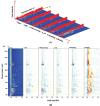Characterization of flavor substances in cooking and seasoned cooking brown seaweeds by GC-IMS and E-nose
- PMID: 38699587
- PMCID: PMC11063391
- DOI: 10.1016/j.fochx.2024.101325
Characterization of flavor substances in cooking and seasoned cooking brown seaweeds by GC-IMS and E-nose
Abstract
The flavor of algae was one of the key factors for consumer acceptance. The objective of this study was to investigate the characteristic volatile compounds in cooking and seasoned cooking edible brown seaweeds (Undaria pinnatifida and Laminaria japonica). The gas chromatography-ion mobility spectrometry (GC-IMS) and electronic nose (E-nose) analysis showed that baking resulted in significant difference in flavor of brown seaweeds. However, the overall effect of cooking was not as significant as that of the seasoning solution treatment. Additionally, brown seaweeds treated with the seasoning solution were more acceptable. Undaria pinnatifida was found to contain 72 volatile flavor compounds, while Laminaria japonica had a total of 70. This study proved the applicability of GC-IMS combined with E-nose technology to detect the changes of volatile components of brown seaweeds after processing, providing beneficial knowledge and basic theory for the deep processing of brown seaweeds.
Keywords: Cooking; Laminaria japonica; Seasoned cooking; Undaria pinnatifida; Volatile flavor components.
© 2024 The Authors.
Conflict of interest statement
The authors declare that they have no known competing financial interests or personal relationships that could have appeared to influence the work reported in this paper.
Figures










Similar articles
-
Flavor profile analysis of grilled lamb seasoned with classic salt, chili pepper, and cumin (Cuminum cyminum) through HS-SPME-GC-MS, HS-GC-IMS, E-nose techniques, and sensory evaluation on Sonit sheep.Food Chem. 2024 Oct 1;454:139514. doi: 10.1016/j.foodchem.2024.139514. Epub 2024 Apr 29. Food Chem. 2024. PMID: 38797107
-
A chemometric approach to characterize the aroma of selected brown and red edible seaweeds / extracts.J Sci Food Agric. 2021 Feb;101(3):1228-1238. doi: 10.1002/jsfa.10735. Epub 2020 Sep 22. J Sci Food Agric. 2021. PMID: 32790090
-
A review of volatile compounds in edible macroalgae.Food Res Int. 2023 Mar;165:112559. doi: 10.1016/j.foodres.2023.112559. Epub 2023 Feb 3. Food Res Int. 2023. PMID: 36869543 Review.
-
GC-MS, GC-IMS, and E-Nose Analysis of Volatile Aroma Compounds in Wet-Marinated Fermented Golden Pomfret Prepared Using Different Cooking Methods.Foods. 2024 Jan 25;13(3):390. doi: 10.3390/foods13030390. Foods. 2024. PMID: 38338525 Free PMC article.
-
Brown Seaweeds for the Management of Metabolic Syndrome and Associated Diseases.Molecules. 2020 Sep 12;25(18):4182. doi: 10.3390/molecules25184182. Molecules. 2020. PMID: 32932674 Free PMC article. Review.
Cited by
-
Effects of Different Water Contents on the Quality Characteristics of Roasted Large Yellow Croaker (Larimichthys crocea) Fillets.Foods. 2025 May 7;14(9):1638. doi: 10.3390/foods14091638. Foods. 2025. PMID: 40361721 Free PMC article.
-
Improvement of Storage Quality of Broccoli Using a Cold-Shock Precooling Way and the Related Molecular Mechanisms.Foods. 2024 Oct 25;13(21):3401. doi: 10.3390/foods13213401. Foods. 2024. PMID: 39517185 Free PMC article.
-
Explainable Deep Learning to Predict Kelp Geographical Origin from Volatile Organic Compound Analysis.Foods. 2025 Apr 4;14(7):1269. doi: 10.3390/foods14071269. Foods. 2025. PMID: 40238501 Free PMC article.
References
-
- An Y., Liu S., Hao F., Wang Y., Tang H. Development and validation of an improved probabilistic quotient normalization method for LC/MS- and NMR-based metabonomic analysis. Chinese Chemical Letters. 2020;31(7):1827–1830. doi: 10.1016/j.cclet.2019.12.011. - DOI
-
- Fisher J.O., Mennella J.A., Hughes S.O., Liu Y., Mendoza P.M., Patrick H. Offering “dip” promotes intake of a moderately-liked raw vegetable among preschoolers with genetic sensitivity to bitterness. Journal of the Academy of Nutrition and Dietetics. 2012;112(2):235–245. doi: 10.1016/j.jada.2011.08.032. - DOI - PubMed
LinkOut - more resources
Full Text Sources
Miscellaneous

